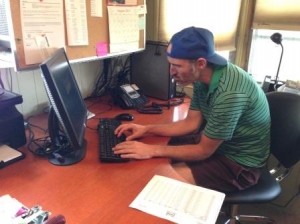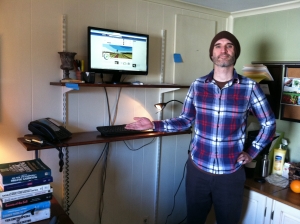How to Make a Stand.
 In the fall of 2012 something radical happened in the Blue Moon sales office: Rebecca and I threw our chairs out the window. Well, okay: we didn’t actually throw our chairs anywhere, but we did push them to the far side of the office. It was something we’d often fantasized about—instead of sitting while working, standing. Every other day it seemed another major media outlet was sounding the alarm over the health hazards associated with prolonged sitting. We decided it was time for a change.
In the fall of 2012 something radical happened in the Blue Moon sales office: Rebecca and I threw our chairs out the window. Well, okay: we didn’t actually throw our chairs anywhere, but we did push them to the far side of the office. It was something we’d often fantasized about—instead of sitting while working, standing. Every other day it seemed another major media outlet was sounding the alarm over the health hazards associated with prolonged sitting. We decided it was time for a change.
The history of the chair, and sitting more generally, is a revealing one. Only after the 16th century did what we know as the modern chair become common anywhere; prior to that, most folks, if they did sit, did so on benches or stools. Though really it wasn’t until the Industrial Revolution that the chair achieved the near-universal ubiquity with which we Westerners now associate it. Whereas in ancient times it had been a means for ruling classes to convey superiority over their subordinates (think thrones or sedans), the chair was now an indispensible part of daily life. Desks were designed around the chair, as were dining tables. Churches, concert halls, and town halls all required sitting in some type of chair. Colin McSwiggen, writing for Jacobin Magazine, points out that, “as chairs became prevalent in schoolrooms, they became a tool for teachers to control the movement of children, whose healthy tendency towards activity made them difficult to teach.” The chair was changing who we were as people, and not always for the best.
Indeed, recent research shows that prolonged sitting has lead to a number of health problems, including obesity and something called ‘metabolic syndrome’, a cluster of conditions including increased blood pressure, high blood sugar, abnormal cholesterol levels, and, yes, even larger posteriors. Sitting also raises the risk of death from cancer and cardiovascular disease. None of which, experts agree, can be offset by extra time at the gym. The only solution is to spend less time sitting.
Having worked for years in standing-intensive retail jobs, Rebecca and I knew we were physically capable of ditching our chairs, but just how was unclear. There was no shortage of standing desks on the market, but they were expensive and didn’t jive with our aesthetic. So we enlisted the help of Blue Moon handymen Carl Ruppert and “Uncle Jim” Rappo to design and build a pair of standing desks which were at once functional and attractive.
To be sure, the transition was not an easy one—several weeks had to pass before our legs adapted—but we knew right away we’d made the right decision. The chronic pain in my neck decreased, and I felt more limber, alert. Rebecca reported similar results. What’s more, standing made us feel in control, as though instead of reacting to the day’s events, we were enacting them. The only downside was the steady stream of confused glances and perplexed comments leveled by coworkers and visitors. One of our crew-members even asked if Jim and Kathy were making us stand. We soon learned that these were teachable moments—Did you know that sitting 11 hours a day raises by forty percent your risk of dying over the next three years? And little by little perceptions began to change.
Since we abandoned our chairs, the standing desk has seen its status as Hottest New Trend trumped by the ‘walking desk’, an upright workstation with a treadmill. All over the world, people are giving their chairs a rest. What about you? Are you ready to make a stand?

